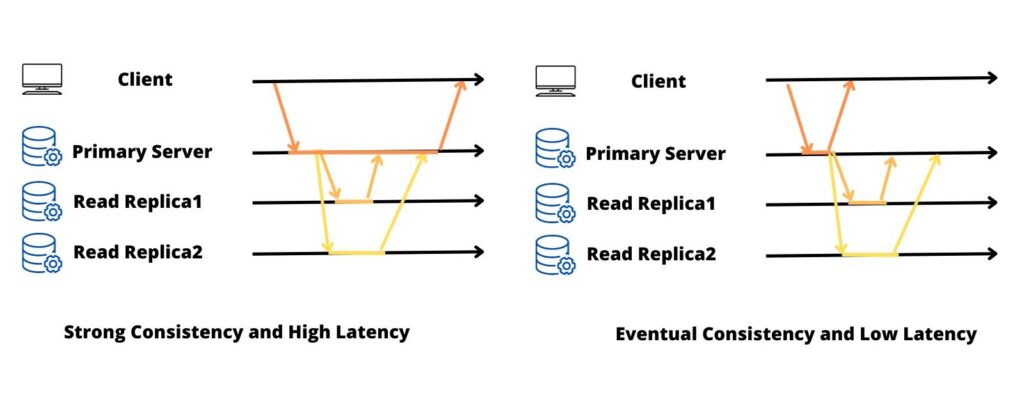In the realm of distributed databases, a critical trade-off emerges between latency and consistency. This dichotomy lies at the heart of data replication strategies, shaping the performance and reliability of database systems. Let’s delve into Latency vs Consistency approaches and explore their implications.
Strong Consistency: Prioritizing Data Integrity
On one end of the spectrum, we have the pursuit of strong consistency. This approach mandates that data is only acknowledged as successfully stored once it resides not only in the primary server but also in all its replicas. The meticulousness of this process ensures data integrity but inevitably leads to higher latency.
Google Cloud Spanner: Leading the Charge
Google Cloud Spanner exemplifies the embodiment of strong consistency in distributed databases. Renowned for its scalability and global replication, Spanner upholds stringent consistency guarantees across its distributed infrastructure.
Eventual Consistency: Embracing Low Latency
Conversely, an emphasis on low latency often steers databases towards eventual consistency. In this paradigm, data is acknowledged as stored once the primary server confirms its reception, sacrificing immediate uniformity across replicas for faster response times.
DynamoDB with Accelerator (DAX): Bridging Latency and Consistency
DynamoDB, bolstered by its Accelerator (DAX), adopts an eventual consistency model, catering to use cases where rapid data access is paramount. By prioritizing low latency, DynamoDB strikes a delicate balance between responsiveness and consistency.

Navigating the Middle Ground: Tunable Consistency Models
Acknowledging the nuanced demands of various applications, some databases offer tunable consistency models. Apache Cassandra stands out in this regard, empowering users to adjust the degree of consistency based on specific requirements.
Apache Cassandra: Customizable Consistency for Diverse Workloads
With its tunable consistency model, Apache Cassandra empowers organizations to fine-tune latency and consistency trade-offs. By allowing granular control over replication factors, Cassandra facilitates optimal performance tailored to distinct use cases.
Striking the Optimal Balance: Fine-tuning Consistency Levels
In practice, the trade-off between latency and consistency constitutes a delicate balancing act. Recognizing the diverse needs of users, modern databases offer flexibility in adjusting consistency levels to achieve an optimal compromise.
Finding Harmony in Consistency Tuning
The ability to tweak consistency settings enables organizations to align database performance with specific application requirements. By striking a nuanced balance between latency and consistency, businesses can optimize resource utilization and enhance user experiences.
In conclusion, the trade-off between latency and consistency serves as a cornerstone in the design and operation of distributed databases. Whether prioritizing data integrity or responsiveness, database architects must carefully calibrate their systems to meet the unique demands of their applications.
Read About: Demystifying Database Performance: A Deep Dive into Storage Engines.
Frequently Asked Questions
- What is the significance of latency vs consistency in distributed databases? In distributed databases, the trade-off between latency and consistency is crucial as it determines the balance between data access speed and data integrity.
- How does strong consistency differ from eventual consistency? Strong consistency ensures that all replicas have the same data at the same time, prioritizing data integrity over low latency. In contrast, eventual consistency allows for temporary discrepancies between replicas, favoring faster response times.
- Which distributed database exemplifies strong consistency? Google Cloud Spanner is a prominent example of a distributed database that prioritizes strong consistency, ensuring that data is synchronized across all replicas before acknowledgment.
- What benefits does eventual consistency offer? Eventual consistency prioritizes low latency, enabling faster data access and response times, which is advantageous for applications where real-time responsiveness is critical.
- How does DynamoDB with Accelerator (DAX) balance latency and consistency? DynamoDB, supplemented by Accelerator (DAX), adopts an eventual consistency model to strike a balance between low latency and acceptable levels of consistency, catering to diverse application requirements.
- Can consistency levels be adjusted in distributed databases? Yes, many modern databases, such as Apache Cassandra, offer tunable consistency models, allowing users to customize consistency levels based on specific application needs.
- What factors influence the choice between strong and eventual consistency? Factors such as application requirements, data access patterns, and performance goals influence the decision between strong and eventual consistency. Applications with stringent data integrity requirements may opt for strong consistency, while those prioritizing speed may favor eventual consistency.
- How does tuning consistency levels impact database performance? Tuning consistency levels allows organizations to optimize database performance according to their unique needs. By adjusting consistency settings, they can strike an optimal balance between latency and data integrity, enhancing overall system efficiency and user experience.